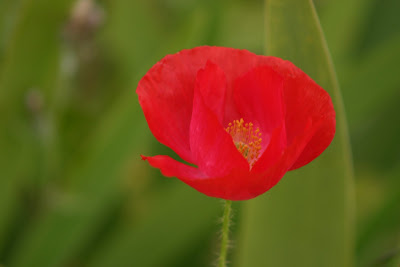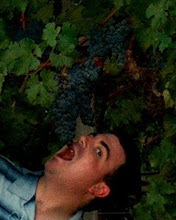The real reason for the drive was to get out of the house and enjoy this nice weather we've had for only a few days. Unfortunately, today was not as nice as previous, but it was still a good day.
From Sonoma, we drove North to Santa Rosa and headed over Calistoga Road to the northern part of the Napa Valley. We stopped along the way and took some pictures, like this...
 This vineyard caught my attention because it appeared to be all one block - vineyards are broken up into blocks with larger row spacing between the blocks making them easier to manage - with no row spacing. I imagine they would harvest (and manage) this vineyard very differently on the bottom than the top because of the slope as well as the sun exposure. Cool stuff. Next time you're driving by a vineyard think about it.
This vineyard caught my attention because it appeared to be all one block - vineyards are broken up into blocks with larger row spacing between the blocks making them easier to manage - with no row spacing. I imagine they would harvest (and manage) this vineyard very differently on the bottom than the top because of the slope as well as the sun exposure. Cool stuff. Next time you're driving by a vineyard think about it.Some small clusters about to bloom....
 We're getting close to bloom. This is when the buds begin to flower and pollinate. It can be a very dangerous time in the vineyard. Without proper pollination and set, the grape clusters will contain both grapes that are growing and grapes that never started. Not a good thing.
We're getting close to bloom. This is when the buds begin to flower and pollinate. It can be a very dangerous time in the vineyard. Without proper pollination and set, the grape clusters will contain both grapes that are growing and grapes that never started. Not a good thing.We also found some pretty flowers today....
I love vineyard pictures with old barns, particularly red ones....
 And for some reason, I have a fascination with wind machines....
And for some reason, I have a fascination with wind machines....
I love vineyard pictures with old barns, particularly red ones....
 And for some reason, I have a fascination with wind machines....
And for some reason, I have a fascination with wind machines....We stopped in Calistoga and walked around. I found these two shops next to each other....
 Who knew I would find two of my favorite things in Calistoga? - wine tasting and candy. Maybe I should think about making a spot in my cellar for candy.
Who knew I would find two of my favorite things in Calistoga? - wine tasting and candy. Maybe I should think about making a spot in my cellar for candy.
We drove into Castello di Amorosa. We didn't get out, but I thought the girls would like to see a castle. They had some pretty flowers and some flags, of course.
 Just looked like a pretty spot up on the hill....
Just looked like a pretty spot up on the hill....
 Who knew I would find two of my favorite things in Calistoga? - wine tasting and candy. Maybe I should think about making a spot in my cellar for candy.
Who knew I would find two of my favorite things in Calistoga? - wine tasting and candy. Maybe I should think about making a spot in my cellar for candy.We drove into Castello di Amorosa. We didn't get out, but I thought the girls would like to see a castle. They had some pretty flowers and some flags, of course.
 Just looked like a pretty spot up on the hill....
Just looked like a pretty spot up on the hill.... After a quick refresh back at home, we headed over to my in-laws house for a swim and a BBQ dinner. Of course, I brought along some wine.
 Unfortunately, the Deerfield Ranch was corked. Corked refers to a bacteria that can live in cork closures and can ruin the wine very quickly. You can read more about it here. It is very easy for humans to detect this taint and once you know the smell, it's something that will generally be easily detectable. The question came up, "what can you do with a corked wine"? I wasn't sure, so a quick search on the web turned up this website. Not sure if it works, but it's worth a shot.
Unfortunately, the Deerfield Ranch was corked. Corked refers to a bacteria that can live in cork closures and can ruin the wine very quickly. You can read more about it here. It is very easy for humans to detect this taint and once you know the smell, it's something that will generally be easily detectable. The question came up, "what can you do with a corked wine"? I wasn't sure, so a quick search on the web turned up this website. Not sure if it works, but it's worth a shot.  It was quite amazing for a 10 year old Chardonnay. There are plenty of red wines that don't hold up that long, so it was a real treat to have a white that was still full of life at that age.
It was quite amazing for a 10 year old Chardonnay. There are plenty of red wines that don't hold up that long, so it was a real treat to have a white that was still full of life at that age.
A foodie shot of the ribs on the BBQ!

Full menu: BBQ pork ribs, corn, rosemary red potatoes, Syrah and flag napkins!
 Syrah and BBQ or grilled foods go together like meat and potatoes. This Syrah came from Zaca Mesa Winery in Santa Ynez Valley near Santa Barbara, CA. It had good structure and aromas and flavors of blackberry, raspberry, clove and licorice. The latter coming through on the long finish. The back label said to drink now or within the next 8-10 years. It was a 2003 and I think we hit a sweet spot. A very nice wine, especially when considering the price of about $20.
Syrah and BBQ or grilled foods go together like meat and potatoes. This Syrah came from Zaca Mesa Winery in Santa Ynez Valley near Santa Barbara, CA. It had good structure and aromas and flavors of blackberry, raspberry, clove and licorice. The latter coming through on the long finish. The back label said to drink now or within the next 8-10 years. It was a 2003 and I think we hit a sweet spot. A very nice wine, especially when considering the price of about $20.
 Unfortunately, the Deerfield Ranch was corked. Corked refers to a bacteria that can live in cork closures and can ruin the wine very quickly. You can read more about it here. It is very easy for humans to detect this taint and once you know the smell, it's something that will generally be easily detectable. The question came up, "what can you do with a corked wine"? I wasn't sure, so a quick search on the web turned up this website. Not sure if it works, but it's worth a shot.
Unfortunately, the Deerfield Ranch was corked. Corked refers to a bacteria that can live in cork closures and can ruin the wine very quickly. You can read more about it here. It is very easy for humans to detect this taint and once you know the smell, it's something that will generally be easily detectable. The question came up, "what can you do with a corked wine"? I wasn't sure, so a quick search on the web turned up this website. Not sure if it works, but it's worth a shot.Luckily, my in-laws have a well stocked cellar and pulled out this 2000 Arrowood Chardonnay.
 It was quite amazing for a 10 year old Chardonnay. There are plenty of red wines that don't hold up that long, so it was a real treat to have a white that was still full of life at that age.
It was quite amazing for a 10 year old Chardonnay. There are plenty of red wines that don't hold up that long, so it was a real treat to have a white that was still full of life at that age.A foodie shot of the ribs on the BBQ!

Full menu: BBQ pork ribs, corn, rosemary red potatoes, Syrah and flag napkins!
 Syrah and BBQ or grilled foods go together like meat and potatoes. This Syrah came from Zaca Mesa Winery in Santa Ynez Valley near Santa Barbara, CA. It had good structure and aromas and flavors of blackberry, raspberry, clove and licorice. The latter coming through on the long finish. The back label said to drink now or within the next 8-10 years. It was a 2003 and I think we hit a sweet spot. A very nice wine, especially when considering the price of about $20.
Syrah and BBQ or grilled foods go together like meat and potatoes. This Syrah came from Zaca Mesa Winery in Santa Ynez Valley near Santa Barbara, CA. It had good structure and aromas and flavors of blackberry, raspberry, clove and licorice. The latter coming through on the long finish. The back label said to drink now or within the next 8-10 years. It was a 2003 and I think we hit a sweet spot. A very nice wine, especially when considering the price of about $20.Of course, no meal is complete with out dessert. On tonight's list was this Mudd Pie from Trader Joe's. It was very tasty.






